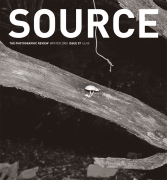EDITORIAL:
Issue 57 — Winter 2008
Issue 57 — Winter 2008
View Contents ▸
Sometimes the scope of a photographic practice becomes suddenly evident by comparison between contrasting projects. Tom Lovelace has been building elaborate looking machines in factory settings to conjure the strange sensation of ambiguity of purpose he found in them when visiting his father's factory as a boy. Sarah Lynch, by contrast, rather than encouraging our supposition about her photographic subjects has pared them down to the simplest forms and a limited range of immediately familiar materials.
Lovelace builds his objects to reverse the machine age principle so that form now suggestively implies function. The machines lurk in the semi-darkness apparently on the cusp of discovering their usefulness, but in reality teasing our imaginations. Lynch's subjects meanwhile are fully revealed to us. They are well lit, candidly presented and repetitious because she hopes that by being explicit her fragile and commonplace objects can stand in for the fragility of all life and all things.
Contrast is also an obvious feature across two projects by Tim Edgar, Rookery and Cobweb: the rookery is black and the cobweb is white. Yet across both series Edgar is interested in the signs of conflict and death within these nesting sites. The rooks do not appear in the pictures but are everywhere suggested by the blackness and the discrete evidence of their presence in the forest. The spider's domain is almost completely abstract and blank but for the fragments of its dismembered prey. As in Lynch's work the clarity of Edgar's pictures suggests a universal as well as a particular interpretation, as in Lovelace's images Edgar leads our imagination into the darkness to discover it.
— The Editors





